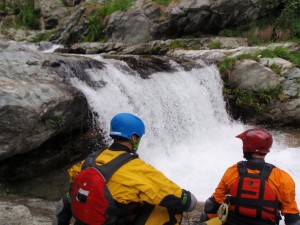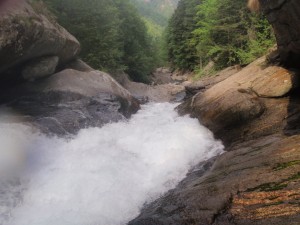Last month I spent a week with my friends paddling rivers in the Val Sesia region of Italy – well known as the steep creeking capital of Europe. Here’s a short video clip of our adventures on the Sesia, Gronda, Sorba, Egua and Semenza rivers.
As well as the paddling, I wanted to test out some research ideas that I can incorporate in my PhD. I’m into my second attempt to complete this, the first one ended in 1997 when I realised I couldn’t juggle a full time job and a young family with a ‘part-time’ doctorate in psychology. So over a glass of red wine, my paddling mates shared some of the factors that help them feel confident on the river. The outcome was fascinating – and has shaped my thinking in a useful way. Each person has a unique ‘inner map’, but there was consistency too; like having a strong team, feeling in good shape physically, and being familiar with the environment.
Catching thoughts
I want to share two stories about what I learned about my own self-confidence. The first comes from our first day on the water. Our plan was to do begin with something relatively mellow, but low river levels limited our choice and we ended up on the Gronda, a classic Grade 4 + run of slides, falls and steep rapids. We split into two groups, and I was paddling with Dean, Andy and Dougie. All was going well, the team dynamics were good and I was enjoying the run. It was toward the end of the trip that I had ‘a moment’ – running an angled slide that left me upside down in a stopper, pushed up against a rock wall. Although the current wasn’t that strong, I made only a poor attempt at rolling before bailing out and swimming with my boat down the next rapid. I was unhurt – and it was actually a good laugh, a bit like a water-park ride rather than anything too threatening. With Andy’s help I emptied my boat, then clambered back up the bank to run the offending drop again, this time in one piece and upright.
Although I laughed it off, the incident opened a small chink in my self confidence. A few hundred metres on, and the next rapid we needed to scout was a 2.5 metre drop that looked messy. The landing area was shallow and rocky, and (at least to me) there wasn’t a promising line.

Crunchy drop on the Gronda
I hesitated, and even though the others paddled it successfully, with a boof on the left hand side, I was unsure. I was reminded of easing over a shallow fall back in the UK, and thought I could the same here. In retrospect, I should simply have followed everyone else’s line. But I didn’t – and this pattern of doing something contrary catches me out when I’m either under or over confident. I dropped off the right hand side, hitting rocks just beneath the water hard and jarring my back. It hurt, and I was worried that I’d done some damage to myself. I thought about stopping at that point – we were very close to the cars and only 500 metres above the Sorba slides where we planned to finish the day’s paddling.
I chose to go on, although I felt quite anxious above the next rapid, as much as anything because I was worried about hurting my back again. By now the second half of the group had caught up, so I watched a couple of people paddle the chunky fall under the bridge before doing it myself. Realising that I could still paddle and that I was just a bit shaken rather than broken, I relaxed into the rest of the run through to the Sorba slides. These famous rapids are visible from the road, and are great fun without being too technical. So a buzzy end to our first day on the water – and although I was feeling less than 100% I was ready for more.
A moment in a cave
In stark contrast, there was a moment a few days later that came close to being a peak experience for me. We had decided to tackle the Heidi run on the upper Sorba. It was to prove the most demanding river of the whole week; a walk-in up the valley then very steep continuous rapids and falls, the first of which were log jammed. The carnage started early, with Dougie landing badly off a 6 metre fall and hurting his ankle. After a couple of hours, Mark, Simon and Darren decided that enough was enough, so they scrambled up the bank to the road leaving me and Dean to continue. We thought we’d soon be caught up by the second group who were a few hundred metres upstream. But they had their own adventures to contend with.
Dean and I soon reached the top of the longest, steepest rapid on the river. It looked awesome, a twisting multi-stage slide that ended in a 2 metre drop. It was made even more challenging by the start. The top of the chute was blocked by a boulder, so you needed to rope down about 3 metres into a cave-like eddy, and then launch straight into the fall. At first I wasn’t keen, then as I looked more my confidence grew. A key thought was that it reminded me of photos I’d seen of rivers in northern California. I have an ambition to paddle there one day, so I figured that if I wanted to keep that dream alive, I needed to paddle this rapid. Dean obliged by helping me lower myself and my boat into the cave, then he went to the bottom to film and provide safety. This meant I was alone, waiting in the dripping cave and looking down the rapid. Here’s the view:

View from the cave, top of the big slide on the Heidi run
What followed were ten of the most remarkable minutes I can remember, as I sat quietly and reflected on the moment, deeply appreciative of being in such a beautiful place, and feeling fully alert and alive. It’s moments of connection like this that make paddling whitewater such a wonderful thing to do. I visualised my line down the rapid once or twice, but soon brought my attention back to the ‘here and now’ of being in the cave. I caught sight of Dean waving his paddle, showing that he was ready. I pushed off, and the rapid sped past in autopilot. Within a couple of seconds I was at the bottom, feeling that wonderful sense of elation that comes from having faced a challenge and survived.
So what were the lessons from these two stories?
First, I need to catch my own thought patterns sooner when my focus wavers. If I notice that I’m contemplating taking a different line from others, I need to check that I’m not under or over confident. In either case I need to spend more time getting ‘grounded’, by paying attention to my breathing and remembering some good experiences.
Second, it helps to have a healthy motivation when there’s a choice to be made. On the Heidi run there were just two of us, so there was less distraction coming from other people’s assessment of go / no-go. I chose to paddle because it was important to me for my own reasons, and this left me in a clear mental space to prepare and paddle.
Third, I was pleased that I kept going after my nose-dive on the Gronda. I was reminded that I have some physical and mental resilience. I had an easy chance and good excuse to stop paddling, but I didn’t. This helped to end the trip on a positive note.


